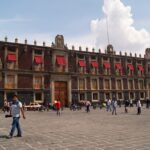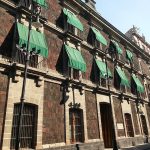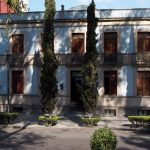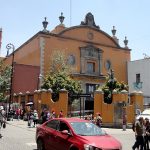
The Convento de la Encarnación (Incarnation Convent) was one of the grandest convents in Colonial Mexico City. Today, it’s the headquarters of the Federal Secretary of Public Education (SEP).
The convent was built under the Dominican Order in 1594. Designed by the Jesuit Luis Benítez, the complex included living quarters, chapels, orchards and a large main cloister. Construction on the cloister began in 1631 and finished in 1648. Half a century later, the Temple of the Incarnation was built with its great octagonal dome.
The complexed is said to have housed more than 300 women, all of whom paid a dowry prior to admittance. It’s reputation was as the finest of its kind. The nuns owned some 85 properties in and around the City (which was then only the City Center). Among these properties were inns and commercial properties, private homes, apartments, farms, and more. With the Reform Laws of 1857, attempts to confiscate and nationalize church assets began to take effect. The nuns sold their many properties over the next decade and were definitively gone by 1867.
The building was then occupied by the National Guard, the National Lottery, the School of Arts and Crafts and the Normal School for Ladies. This though, as early as 1918, began the final conversion of the site. The vast majority of the Convento de la Encarnación complex is today the headquarters and library of the National Secretary of Public Education. It has been since 1921.
The Museum of the Secretary of Public Education opened in 1994. Inisde the SEP headquarters building, the primary purpose was to house and share the extensive artifacts discovered during renovations made between 1989 and 1991. Visitors will also be interested in the Diego Rivera murals. One, titled “The Entrance to the Mine” is immediately outside the museum entrance.
The collection is presented in three areas: the pre-Hispanic, the colonial, and the modern.
Hours: Monday through Friday, 9 a.m. to 5 p.m.
 museodesitiosep@sep.gob.mx
museodesitiosep@sep.gob.mx
 55 3601 1000
55 3601 1000
 http://sic.gob.mx/ficha.php?table=museo&table_id=706
http://sic.gob.mx/ficha.php?table=museo&table_id=706

0.11 kms.

0.12 kms.

La Ciudadela has at least as much history in its own stones as upon its many shelves, and it's always free.

A record of triumph and loss, down to its very stones.

Mexico's National Poet is honored in a modest home from one of Mexico most turbulent periods.

One of the least understood of the City's major monuments, this one's often but a glimpse from the freeway. Understanding it is everything.

One of the Centro Histórico's most stunning museum complexes, the Church of San Pedro & San Pablo isn't one to miss